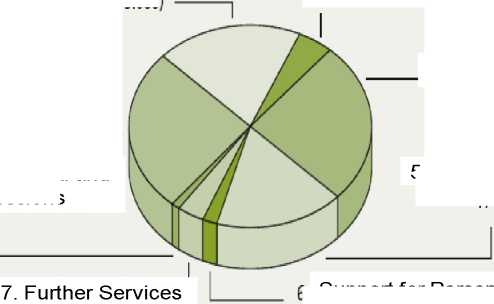17
EmployeesoftheVoluntary WelfareAssociations: 1,41 Mio.
Youth Support
19% (275.060)
Family Support
5% (67.057)
1 % (16.072)
Health Support
26% (368.367)

4. Support for Elderly
26% (367.303)
5. Support for Disabled
17% (242.830)
4% (52.209)
⅛ Support for Persons in
special social Need
2% (26.039)
8. Training for Social and
Nursing Professions
Gesanntstatistik 2004 der BundesarbeitsgeiTieinschaft der Freien Wcihlfahrtspflege e.V. (bagfw)
The comparison of the number of employees of the central voluntary welfare associa-
tions with the number of employees of other economic groups shows the relevance of
this service sector:
• Deutsche Post: 456.71641
• Siemens: 428.000 42
• Daimler: 273.21643
• German Caritas Association: 520.186
• Welfare Service of the Protestant Church in Germany: 452.200
• Workers' Welfare Service : 146.000
• Association of Non-affiliated Charities: 169.900
• German Red Cross: 116.211.
In addition to the employees of the voluntary welfare associations there are
• 2.5 to 3 million volunteers committed in different areas of activity,44
• 70.764 places provided for community services as alternative to military service
for young men (1.5.09)45 and
41 Average 2008. http://investors.dp-dhl.de/de/investoren/der_konzern/aktuelle_konzernzahlen/index.
html (last direct access: July 9 2009).
42 30.9.2008, https://www.siemens.de/ueberuns/daten/zahlen/Seiten/home.aspx (last direct access: July 9
2009).
43 31.12.2008, http://www.daimler.com/dccom/0-5-7155-49-12898-1-0-0-0-0-0-36-0-0-0-0-0-0-0-0.html,
(last direct access: July 9 2009).
44 BAGFW 2003: 17.
45 Bundesamt für den Zivildienst 2009: 2; BAGFW 202: 79-81.
More intriguing information
1. Are Japanese bureaucrats politically stronger than farmers?: The political economy of Japan's rice set-aside program2. The name is absent
3. The Impact of Optimal Tariffs and Taxes on Agglomeration
4. Protocol for Past BP: a randomised controlled trial of different blood pressure targets for people with a history of stroke of transient ischaemic attack (TIA) in primary care
5. Human Development and Regional Disparities in Iran:A Policy Model
6. The name is absent
7. The name is absent
8. Voting by Committees under Constraints
9. On the Relation between Robust and Bayesian Decision Making
10. The bank lending channel of monetary policy: identification and estimation using Portuguese micro bank data